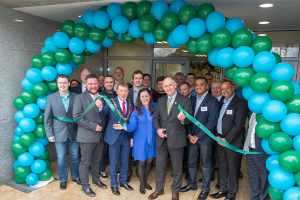HP Helps Deliver Mobility for Australian Students
![]() theCube began its live coverage of the ~11,000-attendee HP Discover conference in Las Vegas today. Wikibon founder Dave Vellante and Wikibon analyst Stu Miniman kicked off the interviews with Gregory Bell, an HP customer and Head of Technical Services for Ballarat Grammar School in Australia. Located one hour outside of Melbourne, Ballarat Grammar is host to roughly 1,400 students ages 3-17 and is supported by a staff of 200. A 12-year veteran at the school, Greg’s main objective is to keep all of the flashing lights green, preventing them from turning red or yellow.
theCube began its live coverage of the ~11,000-attendee HP Discover conference in Las Vegas today. Wikibon founder Dave Vellante and Wikibon analyst Stu Miniman kicked off the interviews with Gregory Bell, an HP customer and Head of Technical Services for Ballarat Grammar School in Australia. Located one hour outside of Melbourne, Ballarat Grammar is host to roughly 1,400 students ages 3-17 and is supported by a staff of 200. A 12-year veteran at the school, Greg’s main objective is to keep all of the flashing lights green, preventing them from turning red or yellow.
Pointing out that Ballarat Grammar is an HP shop through and through, Vellante asks Bell how they deal with competitors when it comes time to purchasing new equipment. “We most certainly look at other vendors for servers, storage, notebooks, etc. – we put them all on the table, make our comparisons, and perform our due diligence,” said Bell. “HP consistently wins – not just on price, even though we get volume discounts, but on build quality as well.” Ballarat Grammar is on its fifth year of using HP tablets for its staff. The most recent purchase included analysis of 4-5 vendors. “HP won easily,” said Bell.
Bell described one of Ballarat Grammar’s more recent and tasking projects driven by the school’s initiative to provide a 1:1 pairing program for its senior students. With this program, the school opted to provide every student and staff member with his/her own HP Netbook running Windows 7 and a copy of the full version of Microsoft Office. Ballarat Grammar’s biggest hurdle with this initiative? Handling all of the additional devices connecting to the network via mobile hotspots throughout the school. Here are some of the key challenges that HP helped Bell overcome:
- Getting down to a single wireless network for the entire campus whereas they used to have four — HP helped Bell move to a single 802.11n network to accommodate connections and bandwidth.
- The classrooms are very close to each other and Bell was experiencing channel collisions. Again, the move to 802.11n allowed Bell to set dynamic/static channels to avoid the conflicts and collisions.
- At any given time, the network could have as many as 500 mobile devices connected; HP’s wireless network and servers, 99% of which are virtualized, are running Windows in VMware and are managed by vCenter, allowing up to 900 devices to connect at any given time – all viewing rich content such as classroom videos from YouTube.
- The students need to be able to access their school content anytime, anywhere, from any device. While the project has not been completed, HP is helping Bell to identify and deploy a network access control (NAC) program that will allow both school-provisioned devices and each student’s own personal device(s) to access the school network.
When asked by Vellante about Ballarat Grammar’s position on “the Cloud” Bell replied “not much.” Bell is not a fan of the hype surrounding the public Cloud. “We’re not keen on trusting other peoples’ privacy policies; we don’t want our student and staff information residing outside our own network,” Bell added.
A message from John Furrier, co-founder of SiliconANGLE:
Your vote of support is important to us and it helps us keep the content FREE.
One click below supports our mission to provide free, deep, and relevant content.
Join our community on YouTube
Join the community that includes more than 15,000 #CubeAlumni experts, including Amazon.com CEO Andy Jassy, Dell Technologies founder and CEO Michael Dell, Intel CEO Pat Gelsinger, and many more luminaries and experts.
THANK YOU











